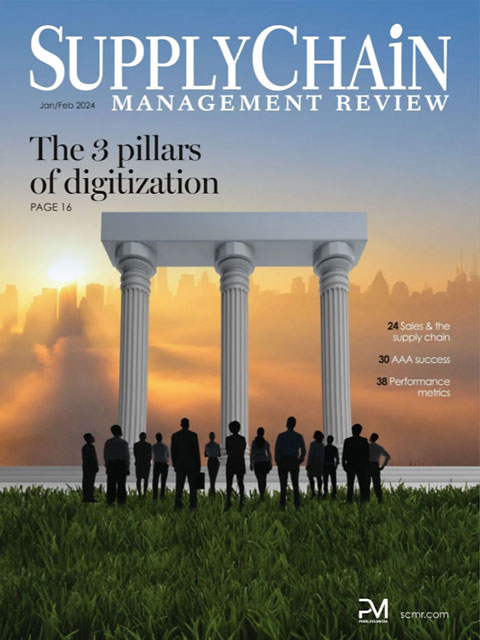Sorry, but your login has failed. Please recheck your login information and resubmit. If your subscription has expired, renew here.
January-February 2024
Back in 2019, we seemed on a consistent path to the future. Then COVID-19 arrived on the global scene, and all predictions went out the window. As 2024 begins, everyone wants to know what the year will look like. I predict continued interest in circular supply chains, cybersecurity, visibility, and digital supply chains, to name a few. But I am not alone. So, I’d like to share five things that I am particularly interested in this year. Browse this issue archive.Need Help? Contact customer service 847-559-7581 More options
All organizations depend on others as part of their operations. Partners such as suppliers, service providers, customers, and others affect how an organization conducts business and the products or services it offers. The supply chain is perhaps one of the clearest examples of this concept in that there are a multitude of organizations involved in sourcing, manufacturing, and delivering goods.
At the same time, organizations must stay innovative to differentiate themselves from the competition and to ensure that they remain resilient in the face of disruptions and uncertainty. Traditionally, innovation has been housed within company walls to keep competitors out. However, this limits the breadth of ideas generated and can put organizations at a disadvantage.
Open innovation is an approach based on collaboration and co-creation between an organization and its partners. This is a natural extension of the close, collaborative relationships many organizations have developed with select suppliers and vendors to ensure mutual benefit. Just as cooperation makes sense to ensure supply chains run smoothly, so does co-creation with trusted entities within an organization’s ecosystem make sense to optimize open innovation.
As with any business effort, organizations vary in their maturity with open innovation. Many who adopted the practice are unsure of how to evaluate its effectiveness and identify areas for improvement. To guide organizations through an assessment of their open innovation efforts and maturity, APQC has collaborated with IBM’s Institute for Business Value to jointly develop an open standard Ecosystem Enabled Innovation Maturity Model (EEIMM).
Supply chains are ecosystems
Underpinning the EEIMM is the belief that open innovation builds on business ecosystems. Within a business ecosystem, each entity, or organization, is affected by the actions and circumstances of the others. When the business landscape shifts, organizations must accommodate their changing relationship with others in their complex, interconnected ecosystem.
Already there are many examples in supply chain of organizations that collaborate closely with trusted partners to achieve business goals and deliver value to customers. The benefit of these ecosystems is that each party brings its own expertise to the relationship, ultimately making the system stronger than its individual pieces.
Particularly with regard to the supply chain, organizations are looking for ways to remain competitive and flexible in the face of potential disruptions and other threats. Open innovation with partners and others within an organization’s ecosystem can result in new ways of addressing these factors and sustaining business performance. Yet organizations often lack ways of evaluating their open innovation practices.
Figure 1: Open innovation components
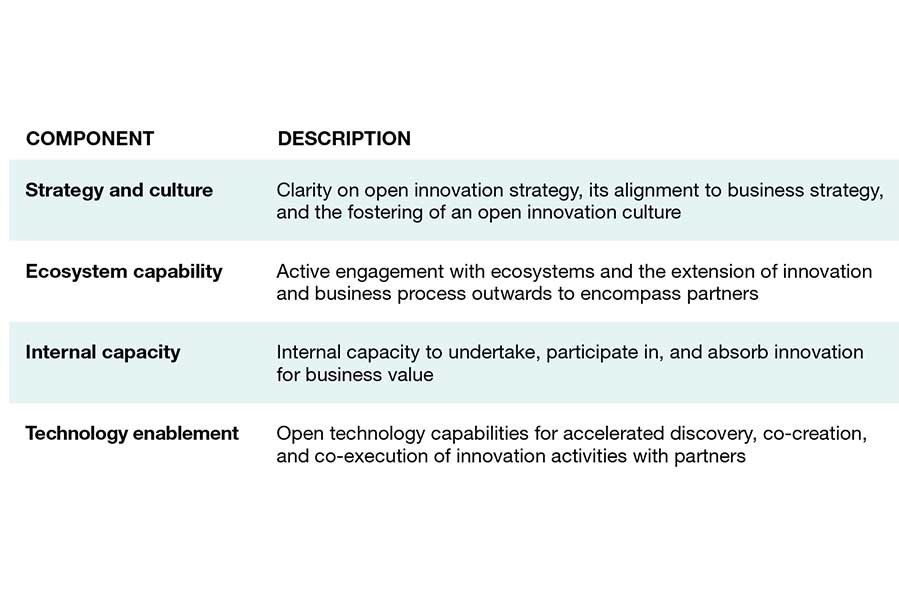
Source: APQC
The ecosystem-enabled Innovation Maturity Model
Recognizing the importance of open innovation to supply chain success and being willing to collaborate, coordinate, and cooperate with partners is not enough. Organizations must think beyond their supply chains to assess their innovation capabilities from strategic, cultural, operational, and technological perspectives.
The EEIMM focuses on four domains that APQC and the IBM Institute for Business Value have determined to be essential to successful open innovation. Figure 1 provides descriptions of each. Organizations evaluate their capabilities and practices within each domain using a five-point maturity scale. They can then take the result of this evaluation and compare their maturity against that of their peers. Figure 2 presents the five-point maturity scale, with a rating of five indicating the highest level of maturity.
Figure 2: Open innovation maturity levels
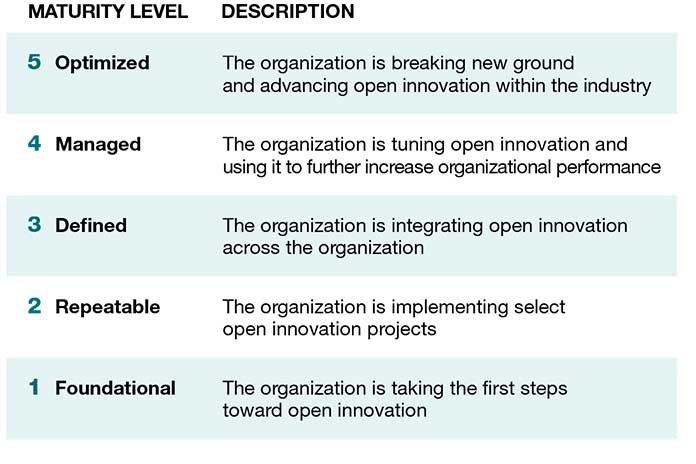
Source: APQC
Benefits of an ecosystem-enabled approach. Organizations that have achieved maturity within each of the four domains exhibit an ecosystem-focused approach to innovation. This approach allows them to innovate faster, at greater levels of scale, and more effectively than less mature peers and competitors.
Mature organizations are also able to perform well on standard business metrics. For example, APQC and IBM found that these organizations achieve over four times the profitability from new products and services than their less mature peers. They also have over three times the revenue growth, and nearly three times the revenue from new products and services than less mature organizations.
Opportunities for average maturity growth. Despite the higher business performance of organizations with more mature open innovation capabilities, there is still room for improvement among most organizations.
Figure 3: Average maturity ratingsfor open innovation capabilities
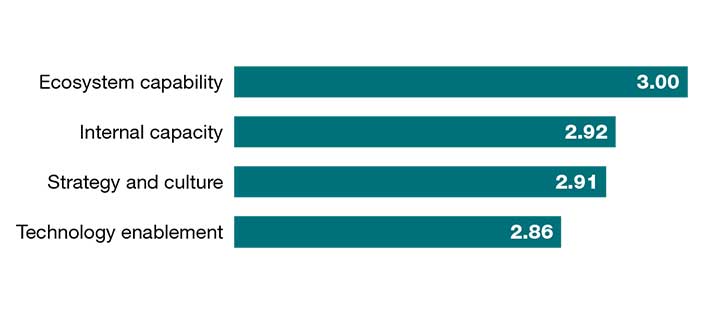
Source: APQC
Figure 3 illustrates the average maturity of organizations’ open innovation capabilities on the five-point scale in the EEIMM.
Each of the domains has an average rating close to or at 3.00, resulting in an average maturity rating across all open innovation capabilities of 2.92 out of 5. Among the four domains, organizations are more mature with regard to ecosystem capabilities. Technology enablement and strategy and culture rank lowest, indicating that many organizations lack the foundational elements needed to support an ecosystem of open innovation.
Maturity by industry. There is a small range of variation when evaluating the maturity of organizations by industry. Electric power utilities and telecom rate highest with an average rating of more than 3.00, but this is still only slightly higher than the average maturity of 2.92 across all industries. Government agencies rate lowest among all industries, perhaps a testament to standardized procedures that can be difficult to change, as well as regulations that work against open and collaborative relationships with other organizations.
Cybersecurity is critical to success
Some business leaders think of innovation in terms of mutually exclusive practices: either an organization keeps its innovation private to protect intellectual property, or it engages in open innovation that leaves it wide open to threats. Mature organizations operate in between.
The fact is that increased openness can create increased risk if security considerations are treated as an afterthought. In addition to the risk of a relationship with an open innovation partner going sour, organizations must also consider how their innovation practices can affect their cybersecurity. These risks not only threaten the organization but also its close partners.
Research from the IBM Institute for Business Value has found that organizations establishing robust security capabilities both for themselves and their business ecosystems benefit from a variety of positive business and operational outcomes. These include deeper engagement and innovation with their partners. To achieve these outcomes, organizations must implement advanced cybersecurity capabilities while coordinating with partners for efficiency, speed, specialization, and scale. These factors will yield more resilient collaboration without sacrificing the benefits of open innovation.
Take action
Given the supply chain vulnerabilities exposed by the pandemic and ongoing risks posed by economic and political uncertainties, the need to innovate within the supply chain has become more urgent. Approaching innovation from an ecosystem perspective supports more robust problem-solving that can lead to better business outcomes.
Figure 4: Eight steps to activate open innovation
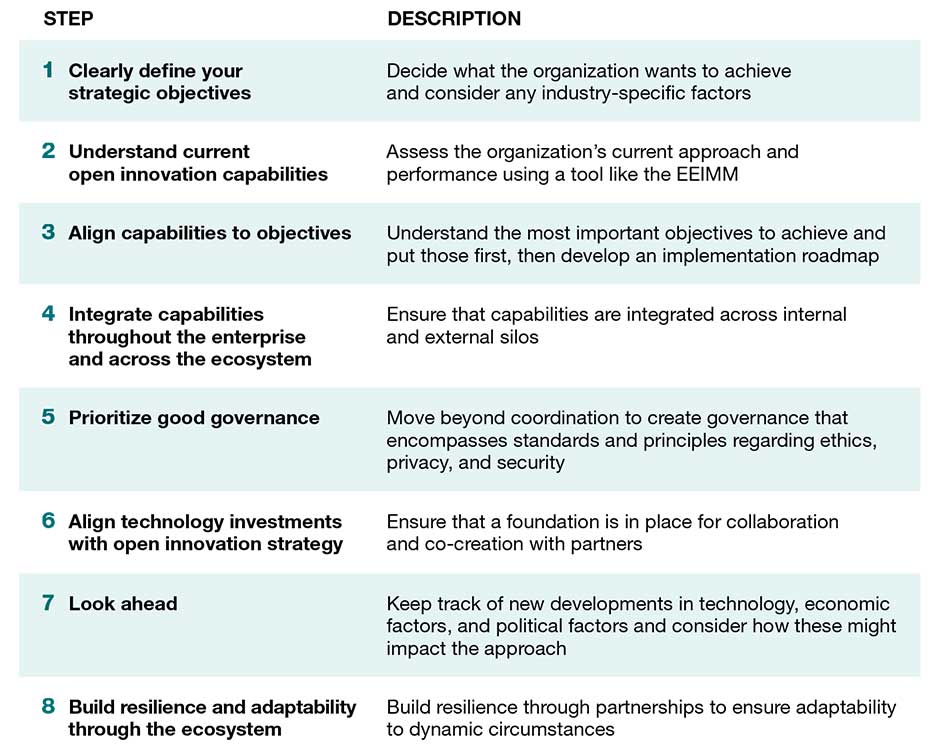
Source: APQC
Organizations must replace their innovation practices with open innovation whenever possible to ensure the most effective innovation effort. However, making the move to open innovation requires preparation. Figure 4 presents eight steps organizations can take to activate open innovation, plus factors that organizations should consider for each step.
The first step for activating open innovation is to gain clarity into the strategic business objectives that the effort will support. As an organization goes through the remaining steps, it may take actions different from its peers depending on what it is trying to achieve. This informs the remaining steps and ensures that the organization and its partners develop capabilities and resilience to address any new circumstances that could affect strategic goals.
As an organization develops its partnerships with others in its business ecosystem or supply chain, it should keep in mind the capabilities of each organization and then further integrate those capabilities to break down silos and ensure consistency. To truly benefit from open innovation, organizations must ensure that all parties operate from a place of shared capabilities, data, and insights.
To learn more, read this complimentary whitepaper Ecosystems and Open Innovation: Co-Create or Stagnate (https://www.apqc.org/resource-library/resource-listing/ecosystems-and-open-innovation-co-create-or-stagnate).
About APQC
APQC helps organizations work smarter, faster, and with greater confidence. It is the world’s foremost authority in benchmarking, best practices, process and performance improvement, and knowledge management. APQC’s unique structure as a member-based nonprofit makes it a differentiator in the marketplace. APQC partners with more than 500 member organizations worldwide in all industries. With more than 40 years of experience, APQC remains the world’s leader in transforming organizations. Visit us at apqc.org and learn how you can make best practices your practices
SC
MR
Sorry, but your login has failed. Please recheck your login information and resubmit. If your subscription has expired, renew here.
January-February 2024
Back in 2019, we seemed on a consistent path to the future. Then COVID-19 arrived on the global scene, and all predictions went out the window. As 2024 begins, everyone wants to know what the year will look like. I… Browse this issue archive. Access your online digital edition. Download a PDF file of the January-February 2024 issue.All organizations depend on others as part of their operations. Partners such as suppliers, service providers, customers, and others affect how an organization conducts business and the products or services it offers. The supply chain is perhaps one of the clearest examples of this concept in that there are a multitude of organizations involved in sourcing, manufacturing, and delivering goods.
At the same time, organizations must stay innovative to differentiate themselves from the competition and to ensure that they remain resilient in the face of disruptions and uncertainty. Traditionally, innovation has been housed within company walls to keep competitors out. However, this limits the breadth of ideas generated and can put organizations at a disadvantage.
Open innovation is an approach based on collaboration and co-creation between an organization and its partners. This is a natural extension of the close, collaborative relationships many organizations have developed with select suppliers and vendors to ensure mutual benefit. Just as cooperation makes sense to ensure supply chains run smoothly, so does co-creation with trusted entities within an organization’s ecosystem make sense to optimize open innovation.
As with any business effort, organizations vary in their maturity with open innovation. Many who adopted the practice are unsure of how to evaluate its effectiveness and identify areas for improvement. To guide organizations through an assessment of their open innovation efforts and maturity, APQC has collaborated with IBM’s Institute for Business Value to jointly develop an open standard Ecosystem Enabled Innovation Maturity Model (EEIMM).
Supply chains are ecosystems
Underpinning the EEIMM is the belief that open innovation builds on business ecosystems. Within a business ecosystem, each entity, or organization, is affected by the actions and circumstances of the others. When the business landscape shifts, organizations must accommodate their changing relationship with others in their complex, interconnected ecosystem.
Already there are many examples in supply chain of organizations that collaborate closely with trusted partners to achieve business goals and deliver value to customers. The benefit of these ecosystems is that each party brings its own expertise to the relationship, ultimately making the system stronger than its individual pieces.
Particularly with regard to the supply chain, organizations are looking for ways to remain competitive and flexible in the face of potential disruptions and other threats. Open innovation with partners and others within an organization’s ecosystem can result in new ways of addressing these factors and sustaining business performance. Yet organizations often lack ways of evaluating their open innovation practices.
Figure 1: Open innovation components

Source: APQC
The ecosystem-enabled Innovation Maturity Model
Recognizing the importance of open innovation to supply chain success and being willing to collaborate, coordinate, and cooperate with partners is not enough. Organizations must think beyond their supply chains to assess their innovation capabilities from strategic, cultural, operational, and technological perspectives.
The EEIMM focuses on four domains that APQC and the IBM Institute for Business Value have determined to be essential to successful open innovation. Figure 1 provides descriptions of each. Organizations evaluate their capabilities and practices within each domain using a five-point maturity scale. They can then take the result of this evaluation and compare their maturity against that of their peers. Figure 2 presents the five-point maturity scale, with a rating of five indicating the highest level of maturity.
Figure 2: Open innovation maturity levels

Source: APQC
Benefits of an ecosystem-enabled approach. Organizations that have achieved maturity within each of the four domains exhibit an ecosystem-focused approach to innovation. This approach allows them to innovate faster, at greater levels of scale, and more effectively than less mature peers and competitors.
Mature organizations are also able to perform well on standard business metrics. For example, APQC and IBM found that these organizations achieve over four times the profitability from new products and services than their less mature peers. They also have over three times the revenue growth, and nearly three times the revenue from new products and services than less mature organizations.
Opportunities for average maturity growth. Despite the higher business performance of organizations with more mature open innovation capabilities, there is still room for improvement among most organizations.
Figure 3: Average maturity ratingsfor open innovation capabilities

Source: APQC
Figure 3 illustrates the average maturity of organizations’ open innovation capabilities on the five-point scale in the EEIMM.
Each of the domains has an average rating close to or at 3.00, resulting in an average maturity rating across all open innovation capabilities of 2.92 out of 5. Among the four domains, organizations are more mature with regard to ecosystem capabilities. Technology enablement and strategy and culture rank lowest, indicating that many organizations lack the foundational elements needed to support an ecosystem of open innovation.
Maturity by industry. There is a small range of variation when evaluating the maturity of organizations by industry. Electric power utilities and telecom rate highest with an average rating of more than 3.00, but this is still only slightly higher than the average maturity of 2.92 across all industries. Government agencies rate lowest among all industries, perhaps a testament to standardized procedures that can be difficult to change, as well as regulations that work against open and collaborative relationships with other organizations.
Cybersecurity is critical to success
Some business leaders think of innovation in terms of mutually exclusive practices: either an organization keeps its innovation private to protect intellectual property, or it engages in open innovation that leaves it wide open to threats. Mature organizations operate in between.
The fact is that increased openness can create increased risk if security considerations are treated as an afterthought. In addition to the risk of a relationship with an open innovation partner going sour, organizations must also consider how their innovation practices can affect their cybersecurity. These risks not only threaten the organization but also its close partners.
Research from the IBM Institute for Business Value has found that organizations establishing robust security capabilities both for themselves and their business ecosystems benefit from a variety of positive business and operational outcomes. These include deeper engagement and innovation with their partners. To achieve these outcomes, organizations must implement advanced cybersecurity capabilities while coordinating with partners for efficiency, speed, specialization, and scale. These factors will yield more resilient collaboration without sacrificing the benefits of open innovation.
Take action
Given the supply chain vulnerabilities exposed by the pandemic and ongoing risks posed by economic and political uncertainties, the need to innovate within the supply chain has become more urgent. Approaching innovation from an ecosystem perspective supports more robust problem-solving that can lead to better business outcomes.
Figure 4: Eight steps to activate open innovation

Source: APQC
Organizations must replace their innovation practices with open innovation whenever possible to ensure the most effective innovation effort. However, making the move to open innovation requires preparation. Figure 4 presents eight steps organizations can take to activate open innovation, plus factors that organizations should consider for each step.
The first step for activating open innovation is to gain clarity into the strategic business objectives that the effort will support. As an organization goes through the remaining steps, it may take actions different from its peers depending on what it is trying to achieve. This informs the remaining steps and ensures that the organization and its partners develop capabilities and resilience to address any new circumstances that could affect strategic goals.
As an organization develops its partnerships with others in its business ecosystem or supply chain, it should keep in mind the capabilities of each organization and then further integrate those capabilities to break down silos and ensure consistency. To truly benefit from open innovation, organizations must ensure that all parties operate from a place of shared capabilities, data,
and insights.
To learn more, read this complimentary whitepaper Ecosystems and Open Innovation: Co-Create or Stagnate (https://www.apqc.org/resource-library/resource-listing/ecosystems-and-open-innovation-co-create-or-stagnate).
About APQC
APQC helps organizations work smarter, faster, and with greater confidence. It is the world’s foremost authority in benchmarking, best practices, process and performance improvement, and knowledge management. APQC’s unique structure as a member-based nonprofit makes it a differentiator in the marketplace. APQC partners with more than 500 member organizations worldwide in all industries. With more than 40 years of experience, APQC remains the world’s leader in transforming organizations. Visit us at apqc.org and learn how you can make best practices your practices
SC
MR


More 3PL
- Orchestration: The Future of Supply Chain
- February and year-to-date U.S. import volume is solid, reports S&P Global Market Intelligence
- 2024 retail sales forecast calls for growth, says National Retail Federation
- ISM reports another month of services sector growth in February
- February manufacturing output declines, notes ISM
- How to Create Real Retailer-Brand Loyalty
- More 3PL
Latest Podcast

 Explore
Explore
Business Management News
- Few executives believe their supply chains can respond quickly to disruptions
- Technology’s role in mending supply chain fragility after recent disruptions
- Survey reveals strategies for addressing supply chain, logistics labor shortages
- How CPG brands can deliver on supplier diversity promises
- How S&OP provides the answer to in-demand products
- AI, virtual reality is bringing experiential learning into the modern age
- More Business Management
Latest Business Management Resources

Subscribe

Supply Chain Management Review delivers the best industry content.

Editors’ Picks





